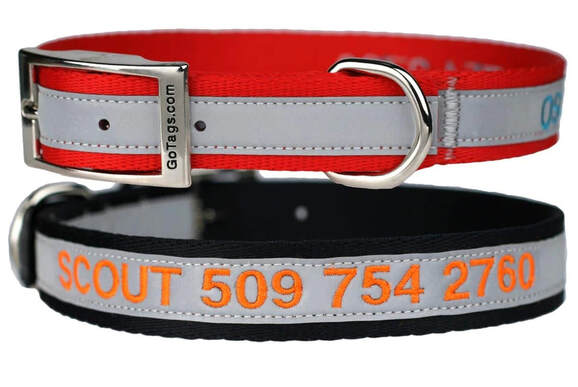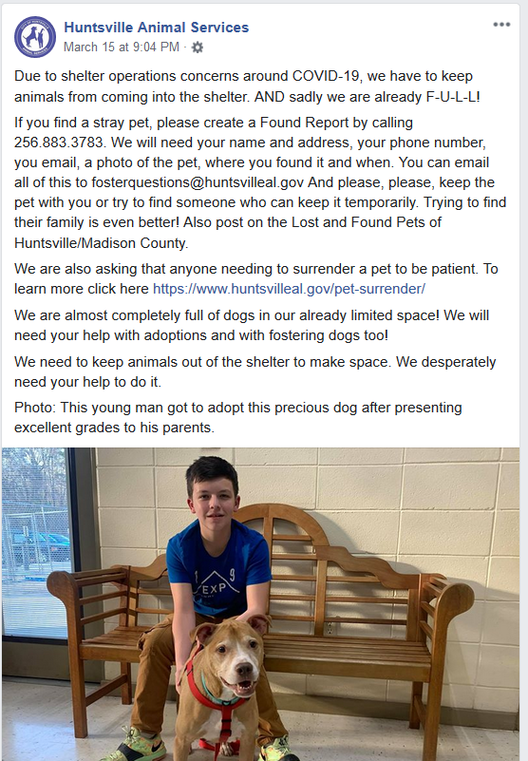|
I published a blog on Wednesday of this week about our COVID 19 public crisis and what animal shelters can do to reduce intake of animals into shelters and increase output of animals from shelters. The impetus for the blog was a call I had with a contact of mine who asked what I knew about rumors that some shelters were resorting to population control killing. I used the blog to again promote the programs and services of the No Kill Equation while highlighting some great things being done by shelters to help animals. Today let's talk about the rest of us. About those of us who share our lives with companion animals. The choices we make regarding our pets which are reflected in our personal behavior are more important now than ever before when it comes to keeping animals alive - not just our own animals, but the animals in our communities. I realize that many people don't give a whole lot of thought to how their personal choices affect how animal shelters operate. What we do as individuals absolutely affects shelters either for good or for bad. Keep Your Dogs Contained Most places have laws that require animals, particularly dogs, be contained so they do not run at large. Now is the time to take extraordinary measures to keep your pets under your control. Do not let your dogs run loose like it is 1845. It is not only dangerous for your dog, but it can be dangerous for the people who encounter your dog whether they are driving or just happen to cross paths. Make sure you keep gates closed, keep doors closed and you teach your children to do the same. If your dog gets loose, he or she is not only apt to be injured, but is apt to end up in a local animal control system. Do your part to keep that from happening not only to reduce the number of dogs in local shelters, but to avoid putting the life of your dog at risk. Your dog who is well behaved at home may do very poorly in a shelter environment and that may lead to his or her death. Make Sure Your Pets Can be Identified Now is the time to have your pet microchipped so he or she can be identified. Chipping is a cheap, easy way to help shelters, veterinary offices and law enforcement authorities know your pet's identity to get them back to you quickly if they do get loose or even if they are stolen. If you are on a Stay at Home Order and cannot get to a veterinary office, you can order an identification tag or collar for your pet so that someone who finds them can contact you easily. For cats, breakaway collars are recommended to avoid strangulation. Identify a Pet Parent I have written about the concept of a Pet Parent before. Much like some people name a Godparent for a child, a Pet Parent is someone who has agreed to take your pet or pets for you in the event of your death, hospitalization or if you can no longer care for them for some reason. Please do not assume that your family members or friends will automatically take your pets and care for them as you do in the event the unthinkable happens. Have an actual conversation with a family member or friend to ensure not only that they commit to take your pets, but that they know how to get to them in your absence and how to care for them. Our Pet Parent is one of my cousins. She has information about pet history, veterinary contacts, local contacts to get into our home and we have made provisions for the costs of care in the event of our deaths. No one likes to think of the worst case scenario, but it is the responsible thing to do. Related to COVID 19, you also need a Pet Parent for short-term housing and care. Think of this as a foster for your pet who will care for your pet temporarily until you have recovered and can care for your pet yourself. Don't allow your pet to end up in your local animal shelter because you didn't have a plan in place. Pet Supplies - Be Ready In the middle of shopping for the human members of your family by having a supply of food to last for a while, don't forget your pets. Make sure you have enough pet food to last a while. Make sure you have your pet's medications refilled and documented with dosages and administering directions. Have a crate and extra supplies on hand if you need to relocate your pets quickly. Keep all animal vaccines up to date and have copies of those records available in the event that boarding becomes necessary. Help Local Animal Shelters There are a host of ways you can help your local animal shelter during this crisis provided you are not under a Shelter at Home Order. You can foster an animal to get him or her out of the shelter and help expedite the adoption process. Many shelters offer sleepover fosters, weekend fosters, or other short-term fosters which not only frees up shelter space, but also helps the shelter to learn about the true personality of the animal. Very few dogs and cats behave in shelters the same way they behave in a home environment. When you foster, you learn about the ability of the animal to ride in a vehicle, get along with other animals, get along with children and about their personalities in general. That information, along with photos and video clips can be used by the shelter to help place the animal in a new home. It's much easier to "market" animals to new homes when more is known about who they really are, beyond what we see. Now is also a wonderful time to adopt a shelter animal. Adopting a new-to-you pet now gives you a wonderful opportunity to help your adopted shelter animal decompress, learn about structure and become a member of your family. It can be hard to do that when working your normal hours at an office. Extra time at home makes the process easier for you and for your new pet.
You can also donate to your local animal shelter to help during the crisis. Some shelters may need food, blankets, beds, or enrichment items like Kongs and treats to keep shelter animals occupied during their shelter stay. Contact your local animal shelter to find out what they may need; many shelter have Facebook pages where they regularly list items they need donated. Donate to a Local Pet Food Bank Even if you have plenty of pet food on hand, others may not. If there is an organization in your community which operates a pet food bank, please consider donating so you can help another person keep their pet during difficult financial times. Many people are losing their jobs and may think they have to surrender their pet to a shelter because they can no longer afford to feed him or her. Many pet food banks taken open bags or boxes of food. No donation amount is too small. If you are not sure if your community has a pet food bank, your local animal shelter or local rescue groups should be able to tell you about places to donate food.
0 Comments
It is obvious that our nation is in a state of crisis. The news of the COVID 19 pandemic is all around us. We’re all doing our best to get through this period together while changing our personal behavior to reduce the loss of life. The situation is evolving so rapidly that it’s enough to cause all of us to feel ill to some degree as we try to keep up. Stress levels are high. The pandemic affects every aspect of our daily lives and those effects extend to places we might not have expected. I got an email from an author contact of mine this morning, Cara Sue Achterberg, wondering what we can to about reports we are hearing that some animal shelters plan to destroy their entire populations of animals in anticipation that they will not be able to manage the intake of animals. I’ve seen posts on social media to the same effect. I’m honestly not sure how pervasive this “mass killing” problem really is on a national level. I've also read about people surrendering pets to shelters because they fear they can get COVID 19 from an animal. The information from the CDC about that rumor is here. Yes, this is a time of crisis. That’s the bad news. But there’s good news. Now is the perfect time to makes changes in the culture in our animal shelters and our communities to keep animals alive. We know how to reduce shelter intake. We know how to increase shelter output. The methods have been know for years. We do those things using the programs and services of the No Kill Equation which was developed by Nathan Winograd and about which I have written many times. Foster Programs Foster programs get animals out of shelters quickly. Many people are working from home. This is a great time for people to foster a shelter pet not only to free up shelter space, but to help the animal get adopted faster. Most animals behave completely differently in a home than they do inside a shelter, so fostering provides a great opportunity to learn more about them and to help them decompress. Photographs, video clips and information about the animals are then used for marketing purposes. I saw a Facebook post just this morning about the Kern County Animal Shelter which is doing drive-up foster pick up of animals to free up shelter space. (image courtesy of the Kern County Animal Services) Adoption Programs Promoting adoption of animals is always important, but now it is critically important. Shelters can use the media and social media to let the public know how to adopt an animal and what animals are available using adoption specials and promotions. In a time of crisis like this, shelters do well to either waive adoption fees (while still doing screening) or drastically reduce those fees. Many shelters have used this opportunity to reach the public about adoptions using humor. These images are from Huntsville Animal Services in Alabama, which is my local tax-funded shelter; they were taken by Kelly Jo (an incredibly talented Lead Kennel Attendant) and posted on the shelter's Facebook page. Just like now is a great time to foster a pet, now is a great time to adopt a pet. With so many people working from home, it provides a wonderful opportunity to help animals decompress from their shelter stay and get settled into a new home. (images courtesy of Kelly Jo) Pet Retention Programs Managed intake is more important now than ever. Most shelters are not obligated to take owned animals and they should not be taking them now. Shelters should be doing all they can to encourage pet retention to keep pets in existing homes or help people rehome pets themselves with family members, friends, co-workers of people they attend church with, know from social groups, etc. Now is a great time for shelters to share information about pet food banks or even partner with local rescue groups to provide free pet food to people who may have lost a job or otherwise be facing a financial crisis. Shelters can also share information about local veterinary resources (to resolve health conditions which may be causing undesirable pet behavior) and about local trainers and behaviorists (to resolve issues with pet behavior which may be the reason someone wants to surrender their pet to an animal shelter). In many cases, a desperate pet owner can be referred to a local rescue group for help. If an owner still insists they must surrender their pet, they should be put on a waiting list to do that once space becomes available. Community Involvement/Public Relations Shelters that work hard to keep their communities informed will always operate more efficiently, but now is the time to really ramp up public relations to get the animal-loving community involved. Use of the media - both television and radio - and social media is the bridge to connect shelters to the public which affects the number of animals entering shelters and the number of animals leaving shelters. Although many shelters assume the public is aware of the need to make better decisions and to adopt, foster, volunteer, etc. most people just don’t think about their local animal shelter unless it is put on their “personal radar” for some reason. If a shelter needs help from the community, it has to say so loudly, clearly and often. Tell people to take extraordinary steps to keep pets contained so they don’t end up in the shelter. Tell people what to do if their pet does go missing. Tell people about how the process works to foster and adopt animals. Tell people about the animals in the shelter who need to be fostered or adopted using images, video clips and information. An engaged public is a active public which can do amazing things in times of need, it only we tell people how they can help. The programs I covered above are just some of the programs of the No Kill Equation. Now is the time to get progressive. Now is the time to make better choices to keep animals alive with the help of the community. I hope that the rumors I’ve heard of shelters essentially “cleaning house” of both animals and bacteria are false. As I told Cara this morning, I think shelters will go one of two ways. Shelters led by progressive people or people who genuinely care will rise to the challenge. They will get creative and do everything possible to help their communities and keep animals alive. Regressive shelters led by people who remain willfully ignorant of progressive programs will likely use the crisis as an excuse to kill animals while making it sound like they are performing some Orwellian public service. What will your animal shelter do? Will it rise to the occasion or will it make excuses? No matter what happens at your local shelter in the weeks and months to come, remember that you are paying for it. These links are not directly related to this blog, but may be helpful for you regarding pets and COVID 19. General Links Animals and Coronavirus Disease 2019 COVID 19 and Animals FAQs from the CDC COVID 19 FAQs from the American Veterinary Medical Association How to Care for Dogs and Cats during Coronavirus |
AuthorI am an animal welfare advocate. My goal is to help people understand some basic issues related to companion animals in America. Awareness leads to education leads to action leads to change. Archives
July 2024
Categories
All
image courtesy of Terrah Johnson
|








 RSS Feed
RSS Feed